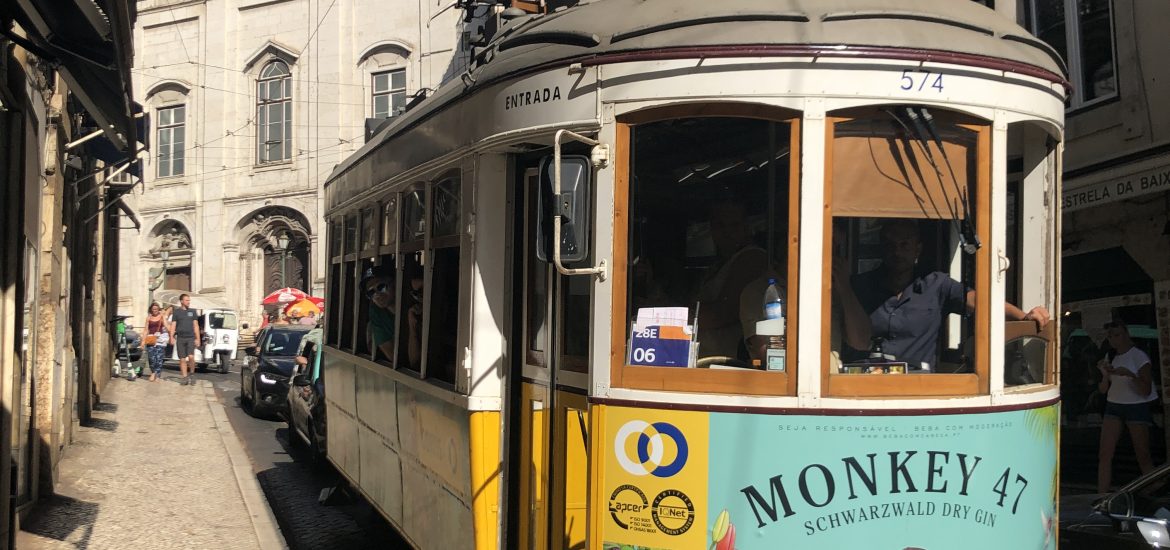Saudade is a Portuguese word that loosely translates to a deep yearning nostalgia for something gone forever.
There is no equivalent word in English. Yet, while it’s hard to explain, this Portuguese emotion is easy to feel as you immerse yourself in the tumbledown yet trendy city of Lisbon.
Funky and fun, Portugal’s capital, and one of the oldest cities in the world, is dazzling with ornate iron balconies, impressive squares filled with bird-stained statues and fountains. Gorgeous tiled walls line the streets filled with people walking along ornate mosaic sidewalks.
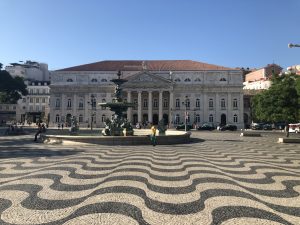
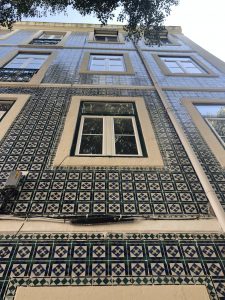
The famous yellow trams lurch along narrow, cobblestone streets, and ancient funiculars transport weary travelers up and down the steep, wafer-thin roads. Taxi cabs, bicycles, and tuk-tuks add to the hustle and bustle of the streets. Legend has it that Lisbon was built upon seven hills, just like Rome. And at first glance, the city seems to sprawl on forever. Fortunately, the historic city center – the Baixa – is easily explored on foot, with the occasional public transport assist.
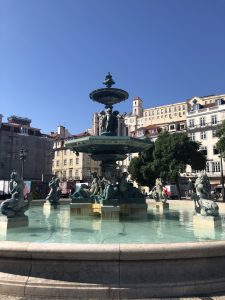
Divided into three downtown neighborhoods, the Alfama, Baixa, and Barrio Alto/Chiado, I find it best to start where the city began.
Alfama, the oldest district, dates back to the 6th century AD. The area can be toured on one of the infamous yellow trolleys, but be aware that they can be insanely crowded. Try to get a seat facing a window. Otherwise, skip it and take one of the lesser known routes if you want to esperience the ride.
Two ancient looking elevators can transport you from the Baixa (city center), but I chose to ride the escalator. Whisking me along a street lined with homes covered by Azulejos – the typically blue and white tiles that cover almost every surface in Portugal – I marvel at residents carrying groceries and packages up and down the adjacent stairs before stepping off onto the tiny street.
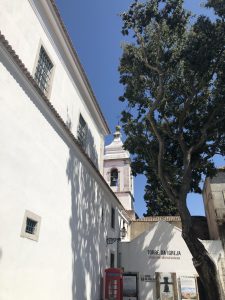
Signs point the way to the Sao Jorge Castle, and I ramble along a tangle of medieval streets. Peering into small terraces and down narrow alleyways offers a glimpse of everyday life.
Passing shops selling souvenirs, the foot traffic grows thicker as I approach the castle.
The castle, built by the Moors, dates back to the mid-11th century. Peacocks, proudly strutting, greet me as I cross the fortification to enter the grounds. The 360-views from this vantage point are phenomenal. Well worth the energy expended to get here. Gaze across a sea of terra cotta tiled roofs as they seemingly pile into the Tagus River. Look to the right for an epic view of the Golden Gate-like 25th of April Bridge, which leads to the Cristo Rei statue.
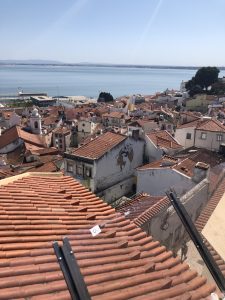
Lisbon has a strong street-art scene, and it’s never more evident than in this neighborhood; entire buildings are covered in vivid colors blurring the lines between art and graffiti. Walking through the area is akin to an open-air gallery. Street performers sing Fado, the haunting Portuguese folk music, and Saudade’s embodiment, from balconies as they lower buckets on ropes to collect tips.
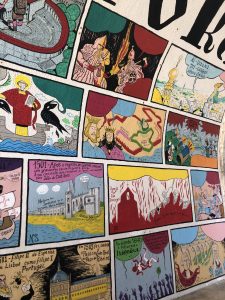
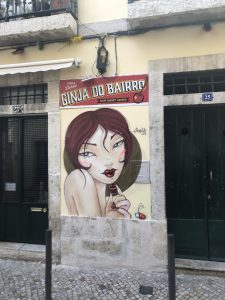
From here, it’s all downhill.
I descend a long staircase, flanked on the right by a massive 8th-century fortified wall that once marked the boundary of Moorish Lisbon. I ponder the hundreds of thousands of people who have walked this route throughout history.
All roads tend to lead to Baixa, which lies in the flat valley between the hills. Perfect for strolling, I find myself in a people-watching stupor. Tourists and locals gather on the squares and in cafes, sipping espresso and enjoying delightful Portuguese pastries.

The architecture is stunning, as are the magnificent mosaic sidewalks lead to Praca do Commercio (Commerce Square) and the Lisbon Riverfront.
There are plenty of incredible squares in Lisbon, but this one, sittings where the Royal Palace once did, is majestic. Envisioned as a gateway to the New World, the square replaced the National Palace, which was destroyed in the great earthquake of 1775.
From here it’s a short trip to the riverfront. Sailboats drift dreamily upon the water as people stroll along the thin sliver of beach. The riverfront is a fantastic place to catch an epic Lisbon sunset. Sip Sangria and relax as the sun sinks behind the backdrop of the 25th of April bridge and dips beneath the Tagus River.

For a vibrant nightlife scene, head to Barrio Alto.
The neighborhood can be reached by elevators, but I chose the funicular. The wooden trolley teeters up a winding street so narrow that pedestrians press up against the walls when we pass. Finally reaching the top, I exit into a crowded scene filled with music and laughter.
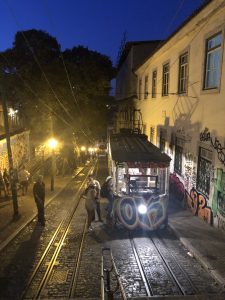
If you’re up for a more formal Fado music performance, Barrio Alto is the place. Fado translates into English as fate. This soulful music style typically consists of a solo singer accompanied by the classical Portuguese guitar and occasionally a mandolin. The haunting folk music wafts out of the Fado clubs lining the skinny streets.
A trip to the neighborhood of Belem is a must.
Take the train or a cab. Easily walkable once you arrive, I chose to rent a bicycle to tour the area. Located along the riverfront, it’s one of the flatter spots making the ride enjoyable.
Home to many famous sights, Belem was the sending off point for voyages in the Age of Discovery. Sailors would stay and pray at the Monastery de Jeronimos; upon their return, they would be welcomed home by the iconic Belem Tower. Both are UNESCO World Heritage sites.
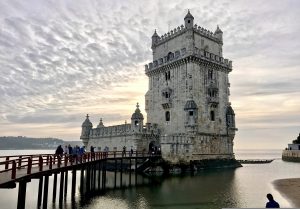
Belem is also home to the Pasteis de Belem bakery, Portugal’s signature pastry, pastel de nata. The delicious cinnamon-dusted, eggy custard tarts can be found throughout Lisbon, but none with this history. The proprietary recipe – said to be an ancient one embraced by monks from the Jeronimos Monastery – has been produced in this former sugar refinery since 1837. Buy a six-pack and enjoy them in the retro blue and white tiled room.
No trip to Lisbon, Portugal, would be complete without a day trip to the magical Sintra.
Fantastic fairy-tale castles and palaces atop craggy hillsides offer views of both Lisbon and the Atlantic Ocean. The summer stomping grounds of Portugal’s kings, it remains magnificent.
A short train ride from Rossio Station in the Baixa takes me straight to Sintra. A light mist surrounds the station. It’s remarkably cooler here in the mountains than it was in Lisbon – almost cold. This is one of the reasons the royals built here. Tour operators and tuk-tuk drivers line the street in front of the station. Rather than taking a tour, I choose to hike through the woods on an ancient trail.
I arrive at the 11th century Moorish Castle after passing by stunning vistas and medieval ruins on a short but steep trek. The one-thousand-year-old ruins are a castle-lovers dream come true. Explore the grounds and walk along the crenelated wall walk for an outstanding view of the Atlantic Ocean.

The sherbert-colored Pena Palace sits on the next hillside and is straight out of a Disney movie. Built by the romantic Prince Ferdinand in the 19th century, it mixes German and Portuguese style elements. The sprawling grounds are lush and feature many surprises, including chapels, sculptures, even giant Sequoia trees.
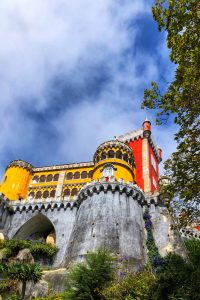

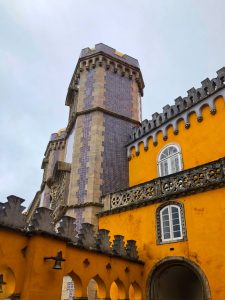
Public art and a variety of vendors dot the street on the way back to town. You’ll also catch a glimpse of the National Palace with its two massive cone-shaped chimneys. Plenty of cafes, most with alfresco seating, are located close to the train station. Enjoy a meal before heading back to Lisbon on the train.
Lisbon, Portugal, has been off the beaten path of European travel in the past but is increasing steadily in popularity.
If your idea of a great trip includes a slower pace, warm and friendly locals, rich culture, dramatic views, and affordable prices, give Lisbon a try.

Travel to Portugal has never been more accessible. TAP Air Portugal offers flights from Houston to Lisbon and layovers in both Lisbon and Porto en route to other European destinations.
As always, thanks for reading! XOXO

Check out the prologue from my upcoming book about my transformative year on the trails HERE.
Can’t wait for the book? Get started living your own story on the trails and transform your life. Join our Facebook Group here.
Keep up with the adventure with the 52 Weeks 52 Hike Journal. Grab your copy HERE.

[ctct form=”1329″ show_title=”false”]

